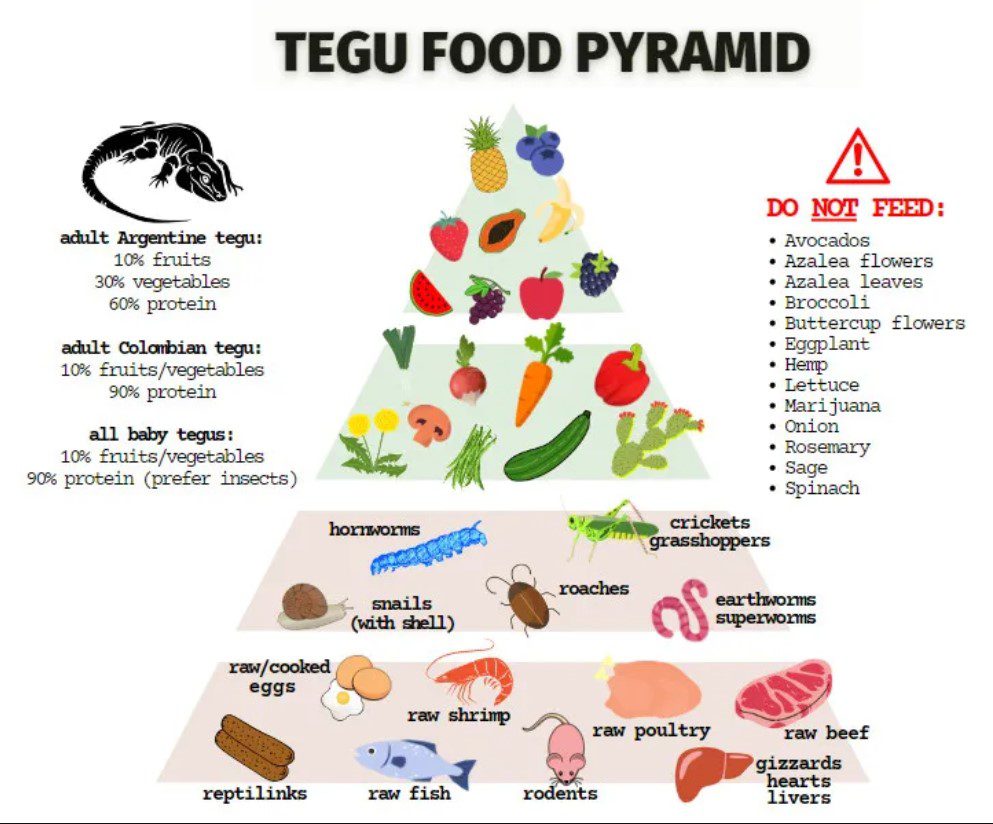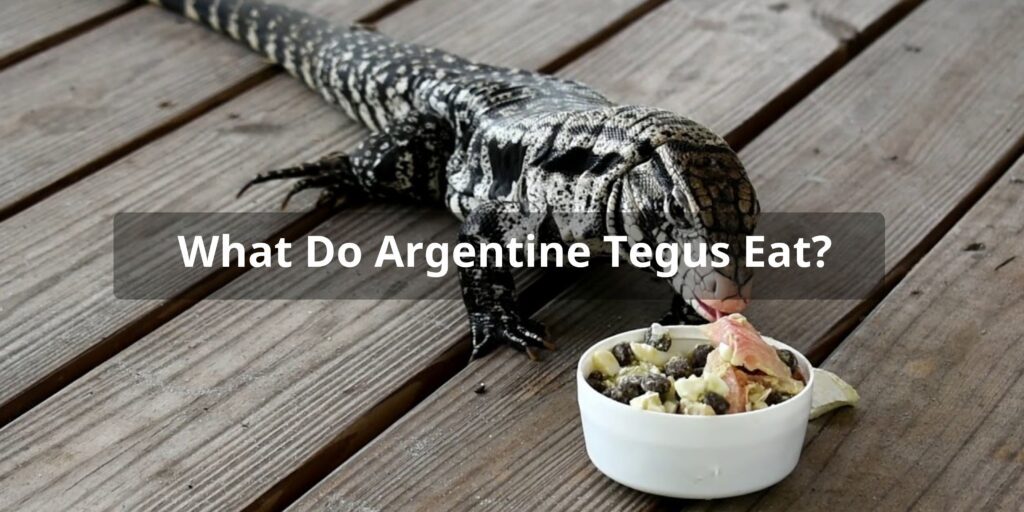Argentine tegus are one of the most popular reptile species kept in captivity. They are known for their impressive size and gentle disposition, making them a great choice for pet owners who want a unique and interesting animal to care for. As with any pet, it is essential to understand what Argentine tegus eat and how to provide them with a balanced and healthy diet. In this article, we will explore the Argentine tegus diet in detail, including their preferred live food options, safe vegetables and fruits for regular consumption, essential vitamins and minerals, foods to avoid, and feeding guidelines.
Argentine Tegus Diet Basics
The Argentine tegus diet consists of a mixture of insects, small animals, and plants. Young tegus require more protein than adults, so their diet should consist of more live food. As they grow older, their diet should shift towards more plant-based foods. Here are some basic guidelines to follow when feeding Argentine tegus:
- Hatchlings and juveniles (up to 12 months old) should be fed every day.
- Adult tegus can be fed every other day or three times a week.
- The insect to plant food ratio for young tegus should be around 70:30, while adult tegus’ diet should be around 50:50.
Essential Foods for Argentine Tegus Diet

Preferred Live Food Options
Live food plays a critical role in the Argentine tegus diet. They need protein to support muscle development and overall growth. Here are some of the preferred live food options for Argentine tegus:
- Crickets
- Dubia roaches
- Superworms
- Mealworms
- Waxworms
- Butterworms
- Silkworms
- Hornworms
- Pinkie mice (occasionally)
It is essential to gut-load the insects before feeding them to your Argentine tegus. This means feeding them nutrient-rich foods that will transfer to the lizard when consumed.
Safe Vegetables for Regular Intake
Vegetables are a crucial part of the Argentine tegus diet, providing essential vitamins and minerals. Here are some safe vegetables for regular consumption:
- Collard greens
- Mustard greens
- Turnip greens
- Dandelion greens
- Kale (in moderation)
- Bok choy
- Squash
- Zucchini
- Green beans
- Carrots
- Sweet potato
- Pumpkin
Recommended Fruits for Argentine tegus Diet
Fruits should be fed in moderation, as they are high in sugar. However, they do provide essential vitamins and minerals. Here are some safe fruits for Argentine tegus:
- Papaya
- Mango
- Blueberries
- Raspberries
- Strawberries
- Watermelon (without rind or seeds)
- Cantaloupe (without rind or seeds)
- Banana (in moderation)
Essential Vitamins & Minerals
Calcium and vitamin D3 are essential for bone development in Argentine tegus. Here are some ways to ensure your Argentine tegus get these nutrients:
- Dust live food with calcium powder at least once a week.
- Provide a UVB light source to stimulate vitamin D3 production.
- Offer calcium supplements as needed.
Foods to Avoid for Argentine Tegus
There are some foods that Argentine tegus should avoid as they can be harmful to their health. Here are some of the most common foods to avoid:
- Avocado
- Rhubarb
- Tomato leaves and stems
- Citrus fruits
- Onions
- Garlic
- Spinach (large amounts)
- Iceberg lettuce
- High-fat content meat
Feeding Guidelines for Argentine Tegus Owners
Here are some practical guidelines for feeding Argentine tegus:
- Feed hatchlings and juveniles every day.
- Provide a variety of live food, vegetables, and fruits to ensure a balanced diet.
- Gut-load insects before feeding them to your Argentine tegus.
- Dust live food with calcium powder at least once a week.
- Provide a UVB light source to stimulate vitamin D3 production.
- Offer calcium supplements as needed.
- Do not overfeed your Argentine tegus, as obesity can lead to health problems.
Understanding Argentine tTegus Hydration Needs
Argentine tegus need access to fresh water at all times. They also require a high level of humidity in their environment, so misting their enclosure regularly is crucial. Soaking your Argentine tegus in shallow water for 30 minutes every two weeks is an excellent way to ensure they are well hydrated and promote proper shedding.
Conclusion
In conclusion, the Argentine tegus diet should consist of live food, vegetables, and fruits to provide essential nutrients and support growth and development. It is essential to avoid harmful foods, gut-load insects before feeding them, dust live food with calcium powder, and offer a UVB light source and calcium supplementsas needed. Following these guidelines, along with providing fresh water and maintaining a humid environment, will help ensure the health and well-being of your Argentine tegus. By understanding their dietary needs and providing a balanced diet, you can enjoy many happy years with your beloved pet.
FAQs About Argentine Tegus Diet
Can I feed my Argentine Tegu only fruits and vegetables?
You should not rely solely on fruits and vegetables for your Argentine Tegu’s diet. While they are essential, Tegus also require protein sources like insects, rodents, and dog food to ensure a balanced diet that meets their nutritional needs.
How often should I feed my pet Argentine Tegu?
The feeding frequency varies with age. Juvenile Tegus need daily meals, while adults can be fed every 2-3 days. Monitoring their weight and adjusting feeding frequency accordingly helps maintain their health.
What types of insects are suitable for Argentine Tegus?
Opt for insects like crickets, mealworms, superworms, and dubia roaches. Prioritize gut-loading and dusting these insects with calcium and other supplements before feeding them to your Tegu.
Is it okay to give my Tegu frozen/thawed rodents?
Yes, offering frozen/thawed rodents like mice and rats is acceptable, especially for adult Tegus. These rodents should be part of a varied diet along with other protein sources for a well-rounded nutritional intake.
Can I offer my Tegu cat or dog food?
Occasionally, you can offer high-quality cat or dog food as a treat. However, avoid making it a primary food source. Ensure the food is protein-rich and low in fillers to contribute to your Tegu’s nutritional balance.
What fruits should I avoid feeding my Argentine Tegu?
Steer clear of citrus fruits like oranges and grapefruits, and limit those high in sugar. Opt for a variety of fruits such as berries, melons, and other low-sugar options to maintain a healthy diet for your Tegu.
How can I provide calcium and vitamins to my Tegu?
Dust insects and food items with reptile-specific calcium and vitamin supplements. This practice ensures your Tegu receives essential nutrients that promote proper bone health and overall well-being.
Should I feed my Tegu raw eggs?
Yes, you can offer raw eggs occasionally. However, it’s advisable to cook them before feeding to reduce the risk of bacterial contamination. Eggs serve as a valuable protein source for your Tegu’s diet.



